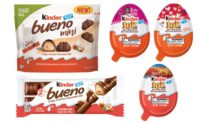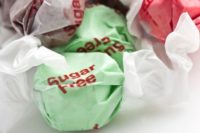
The U.S. confectionery market is expected to see about $6 billion in increased sales in the next five years, and premium products are driving the growth. But the industry is growing faster globally than it is domestically and commodity costs are impacting costs from the farm to the finished product.
Those were just some of the takeaways from yesterday's “Sweet Insights: Maximizing Candy” presentation by Larry Wilson, the National Confectionery Association (NCA)’s v.p of customer relations. His talk was part of the NCA’s Chicago Briefing.
Overall, the U.S. confectionery category accounted for $33.6 billion in sales, but it’s expected to reach about $39.6 billion in five years.
Wilson told the audience that the $6 billion will likely break down to about $4 billion in additional chocolate sales (currently at about $20.6 billion), $1.8 billion in non-chocolate sales (currently at about $10.3 billion), and about $400 million in gum sales (currently at about $2.7 billion).
“The question is, ‘How much do you want?’” Wilson says. “It’s that simple.”
Also during the event Wilson went over the top segments driving growth in the category, including:
- Premium chocolate
- Strong brand image
- Sharable packaging
- Hybrid and line extensions
- Cross-branding
- Seasonal execution
- Translating seasonal business gains into everyday business strength
Premium chocolate accounts for about 8 percent of the U.S. market. Last year, it grew by nearly 15 percent. compared to 4 percent for all chocolate sales. Figures for the latest 12 weeks show chocolate sales being up 2.5 percent, with premium chocolate sales up nearly 18 percent.
Moreover, the NCA sees so much potential for the category, that it’s actually impacted how they’ll showcase it at the Sweets and Snacks Expo. Next year the Expo will feature a “Specialty Marketplace” instead of the “Gourmet Marketplace” as part of an effort to being more inclusive.
As for strong brand image, Wilson says manufacturers have found that investing in their own brand equity has been extremely successful. And that includes opening up single-brand stores, something Godiva, Hershey, Kit Kat, Lindt and Mars/M&M’S have all done.
When it comes to packaging made for sharing, the trend has been especially prevalent in North America and Europe. However, China actually leads the re-sealable market, followed by Japan and then the U.S.
Such packaging is attractive to consumers because they can share the candy, and since it’s re-sealable, it can help with portion control. Also, mini-sharing bags tend to command a higher unit price, Wilson says.
When it comes to hybrid products and line extensions, this trend helps manufacturers capture consumers who are already loyal to their brands. And, it gives candy makers a chance to delve into other aisle. For example, Hershey recently released a Hershey’s Spreads line, which helped it gain a spot in most condiment aisles.
Then there’s the cross-branded products, which can leverage brand equity of more than one iconic brand, increase brand recognition, and expose consumers loyal to one brand to a different product category.
For example, Mars recently teamed up with Kellogg’s to introduce Keebler Chips Deluxe with M&M’S — combining a powerful snack brand with a iconic candy brand.
One of the best times to introduce either hybrids, or new and innovative products is during the various seasons, Wilson says. Customers tend to be looking to try new things, which makes it a good time for trial, and they typically have money in the budget specifically for candy.
Also, most seasons have an emotional tie, just like most candy, making them an ideal match.
“There’s no other category that evokes emotions like this category,” he says.
However, even with all those factors driving growth, manufacturers still need to be conscious of their prices — which is why rising commodity costs have so much potential to cause problems.
As of August 2014, versus a year ago, commodity prices for chocolate were up 31.7 percent, dairy was up 19 percent, sugar was up 20 percent in the U.S. market and hazelnuts were up 80 percent.
“These are real numbers,” Wilson says. “And they impact what’s going on with the overall business.”





